1997-11-21
Katherine Morrow
For years, Peruvian microbiologist Palmira Ventosilla, an expert on tropical disease vectors, has toiled to control malaria, by targeting the spread of the Anopheles mosquito. In 1991, her work took on a greater urgency when P. falciparum — the most deadly type of malaria parasite — spread to Peru.
Ventosilla and her colleagues at the Alexander von Humboldt Tropical Medicine Institute in Lima have developed a low-cost, environmentally friendly alternative to pesticides for use as mosquito killers in the fight against malaria. In Salitral, a town found in Peru's humid, semi-tropical northern coast, Ventosilla's team has been teaching people how to use coconuts as a natural incubator for Bacillus thuringiensis var. israelensis (Bti) strain H-14. This naturally occurring bacterium is harmless to humans and animals, but can kill Anopheles mosquitoes in the larval stage, before they emerge from ponds or other breeding sites.

The incubation process involves inserting a cotton swab soaked in Bti into the coconut, then sealing it with wax. After a few days of fermentation, the coconut is split open and applied to local ponds where mosquitoes are known to breed. This simple procedure requires little training. Except for the Bti swabs, all of the necessary equipment — including candle wax, a sharp knife, and a coconut — is locally available.
Community-based approach
In Salitral, the Bti-coconut technology is the centrepiece of a community-based malaria control program, which was funded for many years by the International Development Research Centre (IDRC). This program aims to give local people sufficient knowledge and resources to control malaria on their own — a necessary strategy in a country such as Peru, where 25% of the population lacks access to health care services. Under this program, community residents receive lessons on how to use the Bti coconut technology, the life cycle of the Anopheles mosquito, and the environmental conditions that favour the spread of malaria. Armed with such information, people can control mosquito levels by applying Bti to breeding sites, paving irrigation channels, and eliminating waste water. And they can protect themselves from mosquito bites by using bednets and window screens, planting lemon and eucalyptus trees (which act as natural barriers to the mosquito), and fumigating their homes by burning eucalyptus branches and leaves.
The Salitral project is now in its final phase, so the focus is on ensuring the sustainability of this community-based approach. Almost half of Salitral's population is under 20 years of age, and Ventosilla is counting on young people to maintain and transmit their knowledge about malaria prevention. They have learned to identify the tiny Anopheles larvae by sight, and know how and when to use Bti to control the insect population.
New horizons
"Our next challenge is to bring the coconut technology, and the community-based approach, to the jungle," says Ventosilla. So far, the team has identified a field site in Madre de Dios, in the southern Peruvian Amazon. Preliminary field trials have shown that Bti is effective in jungle breeding ponds, with an even higher level of larvae control than in the region around Salitral. She believes that the algae and overhanging vegetation cover in these jungle ponds may protect Bti from harmful UV rays, and hopes to test this hypothesis in further trials.
For this work, the researchers include an anthropologist, a sociologist, entomologists, and biologists. During preliminary visits to the Amazon region, they began establishing strong links with local people and institutions. "A major reason why the Salitral project was successful was that a strong commitment was made to the community," explains Ventosilla.
She plans to bring the same level of involvement to Madre de Dios. By integrating innovative, appropriate technologies with community-based learning and action, her team is facilitating the region's long-term development. "To hear people say: 'Thank you for coming to our town, we're better off since you came.' is the best reward," she concludes.
Katherine Morrow is a Canadian writer who recently worked in Cajamarca, Peru.

 (ANSA) - Milan, April 20 - Juventus has been handed a one-match stadium ban because of racist chants directed at Inter Milan's Mario Balotelli during Saturday's 1-1 draw.
(ANSA) - Milan, April 20 - Juventus has been handed a one-match stadium ban because of racist chants directed at Inter Milan's Mario Balotelli during Saturday's 1-1 draw.








